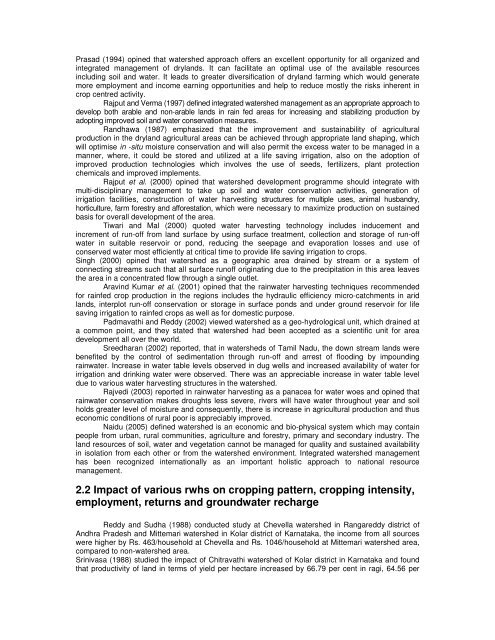Master of Science - ETD | Electronic Theses and Dissertations of ...
Master of Science - ETD | Electronic Theses and Dissertations of ...
Master of Science - ETD | Electronic Theses and Dissertations of ...
You also want an ePaper? Increase the reach of your titles
YUMPU automatically turns print PDFs into web optimized ePapers that Google loves.
Prasad (1994) opined that watershed approach <strong>of</strong>fers an excellent opportunity for all organized <strong>and</strong><br />
integrated management <strong>of</strong> dryl<strong>and</strong>s. It can facilitate an optimal use <strong>of</strong> the available resources<br />
including soil <strong>and</strong> water. It leads to greater diversification <strong>of</strong> dryl<strong>and</strong> farming which would generate<br />
more employment <strong>and</strong> income earning opportunities <strong>and</strong> help to reduce mostly the risks inherent in<br />
crop centred activity.<br />
Rajput <strong>and</strong> Verma (1997) defined integrated watershed management as an appropriate approach to<br />
develop both arable <strong>and</strong> non-arable l<strong>and</strong>s in rain fed areas for increasing <strong>and</strong> stabilizing production by<br />
adopting improved soil <strong>and</strong> water conservation measures.<br />
R<strong>and</strong>hawa (1987) emphasized that the improvement <strong>and</strong> sustainability <strong>of</strong> agricultural<br />
production in the dryl<strong>and</strong> agricultural areas can be achieved through appropriate l<strong>and</strong> shaping, which<br />
will optimise in -situ moisture conservation <strong>and</strong> will also permit the excess water to be managed in a<br />
manner, where, it could be stored <strong>and</strong> utilized at a life saving irrigation, also on the adoption <strong>of</strong><br />
improved production technologies which involves the use <strong>of</strong> seeds, fertilizers, plant protection<br />
chemicals <strong>and</strong> improved implements.<br />
Rajput et al. (2000) opined that watershed development programme should integrate with<br />
multi-disciplinary management to take up soil <strong>and</strong> water conservation activities, generation <strong>of</strong><br />
irrigation facilities, construction <strong>of</strong> water harvesting structures for multiple uses, animal husb<strong>and</strong>ry,<br />
horticulture, farm forestry <strong>and</strong> afforestation, which were necessary to maximize production on sustained<br />
basis for overall development <strong>of</strong> the area.<br />
Tiwari <strong>and</strong> Mal (2000) quoted water harvesting technology includes inducement <strong>and</strong><br />
increment <strong>of</strong> run-<strong>of</strong>f from l<strong>and</strong> surface by using surface treatment, collection <strong>and</strong> storage <strong>of</strong> run-<strong>of</strong>f<br />
water in suitable reservoir or pond, reducing the seepage <strong>and</strong> evaporation losses <strong>and</strong> use <strong>of</strong><br />
conserved water most efficiently at critical time to provide life saving irrigation to crops.<br />
Singh (2000) opined that watershed as a geographic area drained by stream or a system <strong>of</strong><br />
connecting streams such that all surface run<strong>of</strong>f originating due to the precipitation in this area leaves<br />
the area in a concentrated flow through a single outlet.<br />
Aravind Kumar et al. (2001) opined that the rainwater harvesting techniques recommended<br />
for rainfed crop production in the regions includes the hydraulic efficiency micro-catchments in arid<br />
l<strong>and</strong>s, interplot run-<strong>of</strong>f conservation or storage in surface ponds <strong>and</strong> under ground reservoir for life<br />
saving irrigation to rainfed crops as well as for domestic purpose.<br />
Padmavathi <strong>and</strong> Reddy (2002) viewed watershed as a geo-hydrological unit, which drained at<br />
a common point, <strong>and</strong> they stated that watershed had been accepted as a scientific unit for area<br />
development all over the world.<br />
Sreedharan (2002) reported, that in watersheds <strong>of</strong> Tamil Nadu, the down stream l<strong>and</strong>s were<br />
benefited by the control <strong>of</strong> sedimentation through run-<strong>of</strong>f <strong>and</strong> arrest <strong>of</strong> flooding by impounding<br />
rainwater. Increase in water table levels observed in dug wells <strong>and</strong> increased availability <strong>of</strong> water for<br />
irrigation <strong>and</strong> drinking water were observed. There was an appreciable increase in water table level<br />
due to various water harvesting structures in the watershed.<br />
Rajvedi (2003) reported in rainwater harvesting as a panacea for water woes <strong>and</strong> opined that<br />
rainwater conservation makes droughts less severe, rivers will have water throughout year <strong>and</strong> soil<br />
holds greater level <strong>of</strong> moisture <strong>and</strong> consequently, there is increase in agricultural production <strong>and</strong> thus<br />
economic conditions <strong>of</strong> rural poor is appreciably improved.<br />
Naidu (2005) defined watershed is an economic <strong>and</strong> bio-physical system which may contain<br />
people from urban, rural communities, agriculture <strong>and</strong> forestry, primary <strong>and</strong> secondary industry. The<br />
l<strong>and</strong> resources <strong>of</strong> soil, water <strong>and</strong> vegetation cannot be managed for quality <strong>and</strong> sustained availability<br />
in isolation from each other or from the watershed environment. Integrated watershed management<br />
has been recognized internationally as an important holistic approach to national resource<br />
management.<br />
2.2 Impact <strong>of</strong> various rwhs on cropping pattern, cropping intensity,<br />
employment, returns <strong>and</strong> groundwater recharge<br />
Reddy <strong>and</strong> Sudha (1988) conducted study at Chevella watershed in Rangareddy district <strong>of</strong><br />
Andhra Pradesh <strong>and</strong> Mittemari watershed in Kolar district <strong>of</strong> Karnataka, the income from all sources<br />
were higher by Rs. 463/household at Chevella <strong>and</strong> Rs. 1046/household at Mittemari watershed area,<br />
compared to non-watershed area.<br />
Srinivasa (1988) studied the impact <strong>of</strong> Chitravathi watershed <strong>of</strong> Kolar district in Karnataka <strong>and</strong> found<br />
that productivity <strong>of</strong> l<strong>and</strong> in terms <strong>of</strong> yield per hectare increased by 66.79 per cent in ragi, 64.56 per
















